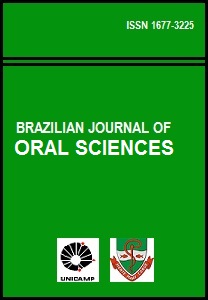Abstract
Candida spp., mainly C. albicans, colonizes oral cavity of infants. Transmission by mother to childbirth, pacifier use, feeding habits and caries are factors related to Candida oral colonization. Some researches related that early childhood caries favor the oral colonization of C. albicans. The present literature review described the presence of Candida spp. in oral cavity of infants and its association with early childhood caries (ECC). The literature was searched for original papers relating Candida, pacifier and baby bottle usage and ECC. The articles were selected using Bireme and Medline databases. Manual tracing of references cited in key papers was also elicited. It can be concluded that Candida spp. colonization in the infants’ oral cavity, especially C. albicans, can be related to the pacifier usage, feeding habits and caries lesions. The early childhood caries favor the C. albicans colonization, although it’s role in the carious process need further studies to be elucidate scientifically.References
McCullough MJ, Ross BC, Reade PC. Candida albicans: a review of its history, taxonomy, epidemiology, virulence attributes, and methods of strain differentiation. Int J Oral Maxillofac Surg. 1996; 25: 136-44.
Sio JO, Minwalla FK, George RH, Booth IW. Oral candida: is dummy carriage the culprit? Arch Dis Child. 1987; 62: 406-20.
Darwazeh AMG, Al-Bashir A. Oral candidal flora in healthy infants. J Oral Pathol Med. 1995; 24: 361-4.
Ollila P, Niemela M, Uhari M, Larmas M. Risk factors for colonization of salivary lactobacilli and candida in children. Acta Odontol Scand. 1997; 55: 9-13.
Mondin MEBG. Incidência de Candida ssp. em crianças com cárie de mamadeira, antes e após o tratamento dental [dissertação]. Piracicaba: Faculdade de Odontologia da Universidade de Campinas; 2003.
Hossain H, Ansari F, Schulz-Weidner N, Wetzel WE, Chakraborty T, Domann E. Clonal identity of Candida albicans in the oral cavity and the gastrointestinal tract of pre-school children. Oral Microbiol Immunol. 2003; 18: 302-8.
Scherma AP, Santos DVO, Jorge AOC, Rocha RF. Presença de Candida spp. na cavidade bucal de lactentes durante os primeiros quatro meses de vida. Cienc Odontol Bras. 2004; 7: 79- 86.
Li Y, Caufield PW. The fidelity of initial acquisition of mutans streptococci by infants from their mothers. J Dent Res. 1995; 74: 681-5.
Drury TF, Horowitz AM, Ismail AI, Maertens MP, Rozier RG, Selwitz RH. Diagnosing and reporting early childhood caries for research purposes. J Publ Health Dent. 1999; 59: 192-7.
Berkowitz RJ. Causes, treatment and prevention of early childhood caries: a microbiologic perspective. J Can Dent Assoc. 2003; 69: 304-7.
Milnes AR. Description and epidemiology of nursing caries. J Public Health Dent. 1996; 56: 38-50.
Marchant S, Brasilsford, SR, Twomey AC, Roberts GJ, Beighton D. The predominant microflora of nursing caries lesions. Caries Res. 2001; 35: 397-402.
Nikawa H, Yamashiro H, Makihira S, Nishimura M, Egusa H, Furukawa M, Setijanto D, Hamada T. In vitro cariogenic potencial of Candida albicans. Mycoses. 2003; 46: 471-8.
Jin Y, Samaranayake LP, Samaranayake Y, Yip HK. Biofilm formation of Candida albicans is variably affected by saliva and dietary sugars. Arch Oral Biol. 2004; 49: 789-98.
Ollila P, Niemela M, Uhari M, Larmas M. Prolonged pacifiersucking and use of a nursing bottle at night: possible risk. J Dent Child. 2001; 68: 33-6, 10.
Comina E, Marion K, Renaud FN, Dore J, Bergeron E, Freney J. Pacifiers: a microbial reservoir. Nurs Health Sci. 2006; 8: 216-23.
Mattos-Graner RO, de Moraes AB, Rontani RM, Birman EG. Relation of oral yeast infection in Brazilian infants and use of a pacifier. J Dent Child. 2001; 68: 33-6.
Ersin NK, Eronat N, Cogulu D, Uzel A, Aksit S. Association of Maternal-Child Characteristics as a Factor in Early Childhood Caries and Salivary Bacterial Counts. J Dent Child. 2006; 73: 105-11.
Hannula J, Saarela M, Jousimies-Somer H, Takala A, Syrjanen R, Kononen E, Asikainen S. Age-related acquisition of oral and nasopharyngeal yeast species and stability of colonization in young children. Oral Microbiol Immunol. 1999; 14: 176- 82.
Akdeniz BG, Koparal E, Sen BH, Ates M, Denizci AA. Prevalence of Candida albicans in oral cavities and root canals of children. J Dent Child. 2002; 69: 189-292.
Zollner MS, Jorge AO. Candida spp. occurrence in oral cavities of breastfeeding infants and in their mothers’ mouths and breasts. Pesqui Odontol Bras. 2003; 17: 151-5.
The Brazilian Journal of Oral Sciences uses the Creative Commons license (CC), thus preserving the integrity of the articles in an open access environment.


